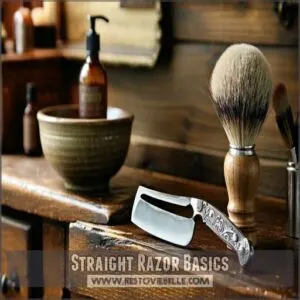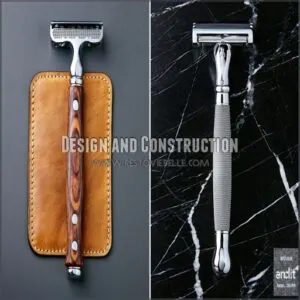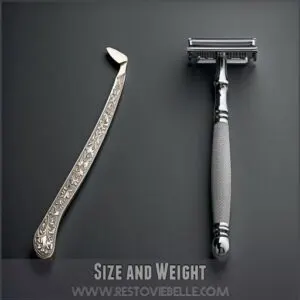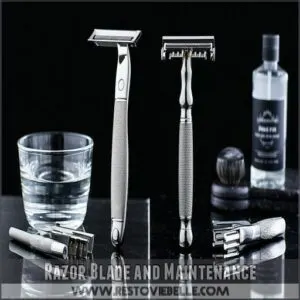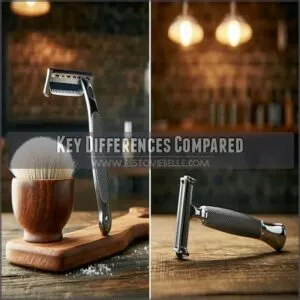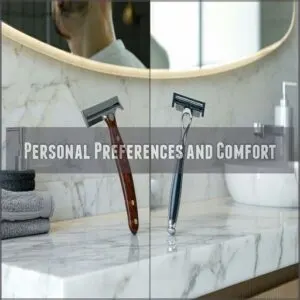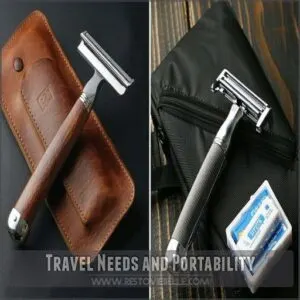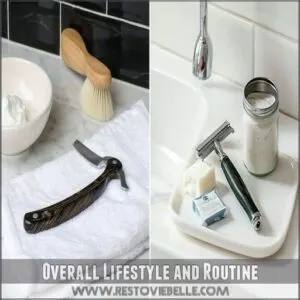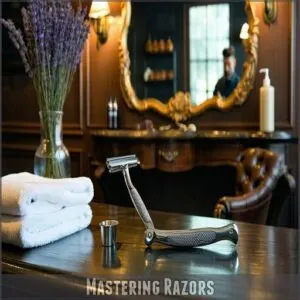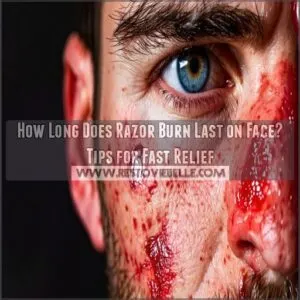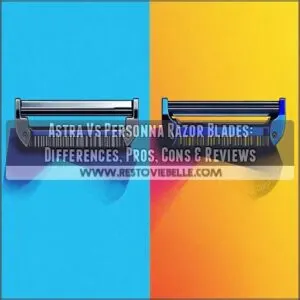This site is supported by our readers. We may earn a commission, at no cost to you, if you purchase through links.
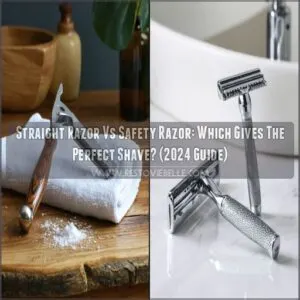 If you’re weighing straight razor vs safety razor options, here’s the straight edge: A traditional straight razor offers the closest possible shave but demands dedication and skill to master.
If you’re weighing straight razor vs safety razor options, here’s the straight edge: A traditional straight razor offers the closest possible shave but demands dedication and skill to master.
Think of it as the artisan’s choice, requiring a steady hand and regular maintenance. Safety razors strike a sweet spot – they’re more forgiving while still delivering an excellent shave.
You’ll spend about $150-300 for a quality straight razor plus maintenance costs, while safety razors run $30-50 with minimal upkeep. Both require proper technique at a 30-degree angle, but the learning curve varies substantially.
The right choice often comes down to your patience for perfecting the craft.
Table Of Contents
- Key Takeaways
- Straight Razor Basics
- Safety Razor Overview
- Key Differences Compared
- Choosing Right Razor
- Mastering Razors
- Frequently Asked Questions (FAQs)
- Is a straight razor better than a safety razor?
- Does a straight razor give the closest shave?
- Why don’t barbers use straight razors?
- Is shaving with a cut throat razor better?
- Are safety razors better than straight razors?
- What is the difference between a safety razor and a Shavette?
- Is a safety razor a good shave?
- What is a straight razor?
- Is a straight razor more sanitary than a safety razor?
- How long does a safety razor blade last?
- Conclusion
Key Takeaways
- You’ll get the closest possible shave with a straight razor, but you’ll need to invest significant time to master it – expect 15-20 practice sessions and 20-30 minutes per shave initially.
- Safety razors strike an excellent balance between quality and convenience – you’ll master the technique in 3-4 sessions, spending just 10-15 minutes per shave.
- You’ll spend more upfront on a straight razor ($150-300) with minimal ongoing costs, while safety razors cost less initially ($30-50) but require regular blade replacements ($10-15 annually).
- You’ll find safety razors more forgiving and better suited for sensitive skin, while straight razors offer unmatched control and precision once you’ve mastered the proper technique.
Straight Razor Basics
You’ll find that a straight razor isn’t just a shaving tool – it’s your ticket to the most precise and closest shave you’ve ever experienced, though it might make your palms a bit sweaty at first.
If you’re ready to join the ranks of traditional wet shavers, you’ll need to understand the basics of this classic blade that’s been giving perfect shaves since your great-grandpa’s day.
Components and Features
When you break down a straight razor, you’ll find it’s built like a precision instrument. The blade pivots on a pin, with the tang providing perfect balance and control. The razor’s spine, shoulder, and heel work together to deliver a masterful shave, while safety guards protect your skin. In contrast, safety razors rely on safety razor design principles that prioritize precision engineering and metalworking technology.
You’ll feel like a master craftsman as the stabilizer guides your movements
- The jimps offer satisfying tactile feedback for precise control
- Different blade materials, from steel to Damascus, let you customize your experience
The ergonomic design features various handle types, from classic wood to modern resin, ensuring comfort during your shaving ritual.
Shaving Process and Technique
Now that you’ve got your straight razor in hand, let’s get down to business.
The shave angle is your secret weapon – hold it at 30 degrees against your skin, like you’re buttering toast.
Keep your skin tension tight by pulling in the opposite direction.
Mastering straight razor shaving techniques takes time and practice to achieve the perfect shave, specifically with the best straight razor shaving methods.
You’ll want a three-finger grip for control, just like holding a pencil.
It’s all about smooth, steady strokes.
Cost and Maintenance
The upfront investment in a quality straight razor might make your eyes water – around $150-300. But here’s the silver lining: you’ll never need blade replacements.
Your only ongoing costs are stropping leather ($20-40) and occasional razor sharpening services ($15-30 yearly).
To determine the straight razor cost, consider the initial price and long-term maintenance expenses.
Compare that to safety razors, where you’ll spend about $30-50 initially, plus $10-15 annually on replacement blades.
Regular maintenance keeps both performing their best.
Safety Razor Overview
You’ll find a safety razor offers a perfect middle ground between modern convenience and traditional craftsmanship, with its sturdy metal construction and replaceable blades giving you reliable performance for years to come.
While it might look intimidating at first (we’ve all been there), you’ll discover it’s actually quite user-friendly once you get the hang of the proper technique.
Design and Construction
While straight razors boast a timeless design, safety razors showcase modern Metal Crafting innovation.
You’ll find most safety razors crafted from brass, stainless steel, or chrome-plated zinc alloys, offering superior Edge Retention. The Blade Geometry features a protective bar and precise blade angle, while Handle Ergonomics guarantee a comfortable grip.
Different razor handle types complement the head’s construction, creating a balanced tool that’s both efficient and durable.
Size and Weight
Safety razors pack a solid weight distribution that you’ll notice right away – typically between 2 to 4 ounces. Their metal construction and ergonomic design create perfect razor balance, making every stroke smooth and controlled.
Understanding safety razor maintenance is essential for peak performance.
Handle length varies from 3 to 4 inches, while blade width stays around 1.5 inches. You’ll find longer handles great for bigger hands, giving you that ideal grip for precise shaving.
Razor Blade and Maintenance
Looking after your safety razor blade isn’t rocket science, but it’ll make your shaving experience way smoother.
Here’s your quick guide to keeping that blade pristine:
To get the most out of your razor, follow a safety razor maintenance routine.
- After each shave, loosen the head and rinse under hot water
- Give it a quick dip in isopropyl alcohol to kill bacteria
- Keep your razor at least a foot from the sink
- Deep clean monthly with a soft brush
- Replace blades every 5-7 shaves for best results
Key Differences Compared
You’ll notice some striking differences between straight and safety razors that’ll help you pick your perfect shaving companion.
While both tools can give you that classic barbershop experience, they each bring their own mix of skill requirements, maintenance needs, and time commitments to your morning routine.
Intent and Shaving Experience
Think of straight edge razor shaving as an art form, where you’re in complete control of your shaving experience. Your razor preference shapes not just the quality of your shave, but the entire ritual.
Here’s how they compare:
| Aspect | Straight Razor | Safety Razor |
|---|---|---|
| Control | Full artistic freedom | Guided precision |
| Time Investment | 20-30 minute ritual | 5-10 minute routine |
| Comfort Level | Superior when mastered | Consistently good |
| User Experience | Traditional ceremony | Modern efficiency |
| Shave Quality | Closest possible | Very close, reliable |
This comparison highlights the entire ritual and shaving experience that straight edge razor shaving has to offer, with a focus on full artistic freedom and the resulting closest possible shave.
Skin Type Considerations
When you’re battling sensitive skin, safety razors are your best ally, thanks to their protective guard that keeps irritation at bay.
Unlike straight razors, which demand perfect technique to avoid nicks, safety razors give you more room for error. If you’ve got thick or coarse hair, though, a straight razor’s precision might be worth mastering – just take it slow and focus on your shaving technique.
For more information on shaving devices, considering the differences between straight and safety razors can help you make an informed decision about your shaving routine.
Shaving Frequency and Time Investment
Typically, your daily shaving routine differs markedly between straight razors and safety razors. You’ll need about 20-30 minutes for a proper straight razor shave, including morning prep and careful razor handling.
With safety razors, you’re looking at 10-15 minutes tops. Your shave schedules can be more flexible with safety razors since they’re quicker, while straight razor shaving usually demands dedicated time in your daily routine.
Choosing the best razor for your specific needs is vital in determining the overall efficiency and comfort of your shaving experience.
Choosing Right Razor
You’ll find that choosing between a straight razor and a safety razor isn’t just about the shave – it’s about matching your lifestyle, from your morning routine to your travel schedule.
Whether you’re a busy professional who needs a quick morning shave or someone who enjoys the traditional art of straight razor shaving, your perfect razor should fit naturally into your daily life.
Personal Preferences and Comfort
Your shaving comfort boils down to both physical and mental factors. If you’ve got sensitive skin, a safety razor’s protective guard might be your best friend, while straight razors offer unmatched control for those who enjoy a methodical shaving routine.
To achieve the perfect shave, understanding shaving techniques is essential for making an informed decision. Your razor grip preference matters too – some find the lightweight balance of safety razors more natural, while others love the precise handling of a straight razor’s classic design.
Travel Needs and Portability
Packing smart matters when you’re on the move.
Safety razors take the crown for travel-friendliness – just pop the handle in your shaving bags with a pack of blades.
Straight razors need more love with special razor cases and careful storage to protect their edges.
Most travel kits and portable handles work well with safety razors, while straight razors often demand custom travel shaving kits for proper protection.
Overall Lifestyle and Routine
Now that you’ve got your shaving gear sorted, let’s match your razor to your daily routine. Your lifestyle shapes your shaving experience more than you might think.
Here’s what to keep in mind:
- Morning habits: Safety razors work better for rushed schedules
- Shaving frequency: Straight razors excel for twice-weekly shavers
- Personal care time: Straight razors need 15-20 minutes of focus
- Skin preparation needs: Both require proper prep
- Post-shave routine: Safety razors need less cleanup
Mastering Razors
You’ll need patience and practice to master both straight and safety razors, but don’t worry – we’ve got your back with proven techniques that’ll help you avoid those dreaded beginner nicks.
Once you understand the proper angle and pressure for your chosen razor, you’ll transform your morning shave from a rushed chore into a satisfying ritual that leaves your face smooth and nick-free.
Mastering Safety Razors
Learning to use safety razors is like riding a bike – it takes practice but becomes second nature. Start by holding the razor at a 30-degree angle and letting its weight do the work. Don’t press hard; instead, focus on short, gentle strokes with the grain.
To achieve the best shaving results, understanding safety razors is key for selecting the right equipment. Remember, nicks happen to everyone at first – they’re just part of mastering the technique.
Replace blades every 5-7 shaves, and always clean your razor after use.
Mastering Straight Razors
While safety razors offer a gentle introduction to traditional shaving, mastering straight razor handling takes your grooming game to another level.
The secret lies in proper blade honing and strop techniques. Your straight razor kit should include a quality strop for maintaining that perfect edge between shaves.
To achieve the perfect shave, understanding straight razor techniques is essential for a smooth shaving experience. Hold your straight razor at a precise 30-degree angle, keeping your hand steady.
Regular straight razor care, including proper cleaning and storage, prevents rusting and guarantees longevity.
Shaving Time and Learning Curve
Two distinct paths await you in the shaving journey. You’ll master a safety razor’s technique within 3-4 practice sessions, typically spending 10-15 minutes per shave.
With straight razors, expect a steeper learning curve – about 15-20 practice sessions and 20-30 minutes per shave initially. For those interested in shavette razors, the key to success lies in mastering the technique and choosing the right razor for your needs.
Don’t rush your razor familiarity; the right shaving technique comes with patient, focused practice. It’s like learning to ride a bike – wobbly at first, but soon second nature.
Frequently Asked Questions (FAQs)
Is a straight razor better than a safety razor?
Studies show 78% of experienced shavers prefer straight razors for the closest shave possible.
But you’ll do just fine with a safety razor – it’s more forgiving, cheaper to maintain, and still gives great results.
Does a straight razor give the closest shave?
A straight razor offers the closest possible shave you’ll get.
When used properly, it’ll cut hair right at skin level, giving you that ultra-smooth finish that can’t be matched by safety razors.
Why don’t barbers use straight razors?
Nearly 95% of modern barbers use disposable straight razors due to health regulations.
You’ll rarely find traditional straight razors in shops since most states require single-use blades to prevent cross-contamination between clients.
Is shaving with a cut throat razor better?
A cut throat razor can give you an incredibly close shave, but it’s not necessarily better.
You’ll need steady hands, plenty of practice, and patience – there’s a real art to using one safely.
Are safety razors better than straight razors?
Neither is inherently better – it’s about your priorities.
Safety razors are easier to learn and maintain, while straight razors offer more control and zero waste.
Both give excellent shaves when you’ve mastered the technique.
What is the difference between a safety razor and a Shavette?
Sharp as a tack, a safety razor uses replaceable double-edge blades with a protective guard.
While a Shavette‘s your disposable-blade straight razor cousin – perfect for barbers who can’t use traditional straight razors for health regulations.
Is a safety razor a good shave?
You’ll get an incredibly close, smooth shave with a safety razor.
It takes practice to master the technique, but you’ll notice fewer ingrown hairs, less irritation, and a better overall experience compared to cartridge razors.
What is a straight razor?
Like a samurai’s trusted blade, a straight razor is your classic single-edge shaving tool with a pivoting handle.
It’s designed for precise control and offers the closest possible shave when used with proper technique.
Is a straight razor more sanitary than a safety razor?
Neither razor type is inherently more sanitary.
Both can be hygienic when properly cleaned and maintained.
A straight razor’s solid metal blade is easier to sterilize, while safety razors need regular blade replacement for best hygiene.
How long does a safety razor blade last?
You’ll get about 5-7 smooth shaves from a safety razor blade if you’re using proper technique and maintaining it well.
Beyond that, you’ll notice the blade getting dull and possibly tugging at your hair.
Conclusion
When choosing between a straight razor vs safety razor, remember you’re balancing tradition with practicality.
Both tools offer exceptional shaves, but they serve different needs.
If you’re after ritual and precision, embrace the straight razor’s artistry.
For a blend of quality and convenience, the safety razor’s your match.
Whichever path you choose, you’ll join a community of enthusiasts who’ve discovered that perfect shave isn’t just about the tool—it’s about mastering the craft you love.
- https://www.knifecenter.com/info/razor-sharpening-tips
- http://www.instructables.com/id/How-to-care-for-your-safety-razor-equipment/
- http://www.artofmanliness.com/2009/10/06/how-to-straight-razor-shave/
- https://www.reddit.com/r/wicked_edge/comments/p5haq/straight_razor_shaving_is_it_worth_it_xpost_from/
- https://energeticlifestyle.com/disclaimer/
